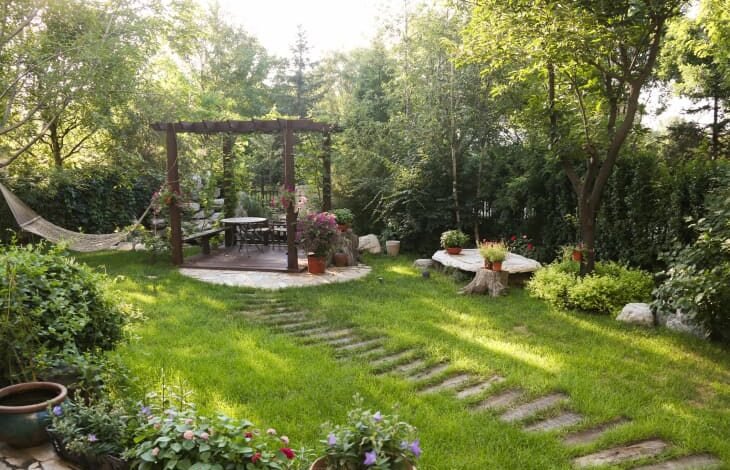Outdoor Project Checklist: Essential Tools and Materials You Need

Introduction
Outdoor projects have become an essential part of home improvement and personal enjoyment. Whether it’s creating a relaxing outdoor lounge, cultivating a beautiful garden, or adding a functional patio for entertaining guests, outdoor projects enhance the aesthetic value of your home while providing a welcoming environment for family and friends. These projects also increase your property’s curb appeal, making them a great investment.
With the right guidance, any homeowner can take on an outdoor project, whether you’re looking to transform your backyard or simply add a small feature to enhance your landscape. This comprehensive guide will walk you through the process of selecting the right project, sourcing materials, and successfully executing your plans. From budgeting to planning to final touches, this guide offers helpful tips for ensuring your outdoor space is both beautiful and functional.
Outdoor projects vary widely in scale, from small decorative improvements like garden benches to larger endeavors like building a custom deck or installing an outdoor kitchen. With the right approach, you can create a stunning outdoor area that suits your lifestyle and preferences. Let’s dive in!
Choosing the Right Outdoor Project for Your Space
Before jumping into your outdoor project, it’s essential to assess your space and determine what will work best for your needs. This step involves understanding your outdoor area’s limitations and possibilities. Whether you have a sprawling garden or a compact backyard, knowing how to make the most of your available space is key to achieving the desired outcome.
Assessing Your Outdoor Area
Start by evaluating the size, shape, and layout of your outdoor area. A large backyard offers more flexibility in terms of design, allowing for features like patios, fire pits, and even swimming pools. In contrast, a small yard may require creative solutions like vertical gardens, compact seating areas, or multi-purpose features that maximize space.
Consider the terrain of your space as well. If your outdoor area is uneven or slopes, you may need to level the ground before installing certain structures, such as a patio or a deck. Additionally, take note of the climate and weather patterns in your area. For example, if you live in a region with heavy rainfall, a durable outdoor structure made from weather-resistant materials would be ideal.
Budgeting for Your Project
Once you have a clear idea of your space, the next step is setting a budget. Outdoor projects can range from affordable DIY tasks to costly professional renovations. Knowing your budget from the start helps you prioritize your project and choose appropriate materials. Consider all aspects of the project, including labor costs, materials, tools, and possible maintenance expenses.
If you’re working with a tight budget, there are several ways to save costs without compromising on quality. For instance, you can repurpose existing materials like bricks or stones, or tackle smaller projects like gardening, which require minimal investment. Conversely, if your budget allows, you can opt for high-end materials, custom features, or professional help for larger-scale outdoor renovations.
Popular Outdoor Projects
There are countless outdoor projects to choose from, depending on your goals and budget. Some popular ideas include:
- Landscaping: Cultivate a lush garden with flowers, shrubs, and trees that suit your climate.
- Patios and Decks: Outdoor patios and decks offer functional spaces for entertaining and relaxing.
- Outdoor Kitchens and Dining Areas: Perfect for those who love cooking outdoors, with features like grills, countertops, and refrigerators.
- Fencing and Pergolas: Define your outdoor space with elegant fencing, or add a pergola for shade and style.
- Pathways and Walkways: Create winding paths that lead to hidden garden areas or outdoor seating spaces.
Each of these projects adds charm and functionality to your outdoor living area, so choose one that suits your personal style and lifestyle.
Essential Tools and Materials for Outdoor Projects
No outdoor project can be completed without the proper tools and materials. Whether you’re planting a garden or building a deck, the right equipment ensures your project runs smoothly and safely. This section will cover the essential tools you’ll need, as well as how to choose the best materials for your outdoor project.
Basic Tools You’ll Need
For most outdoor project, a few basic tools are essential. First, you’ll need basic hand tools like shovels, rakes, and hammers to prepare the ground and carry out simple tasks. A measuring tape and level are crucial for ensuring your structures are aligned and level. Power tools, such as drills, saws, and sanders, are indispensable for larger projects, especially those involving wood or heavy-duty construction materials.
If your project involves more intensive tasks, such as building a patio or deck, you’ll also need specialized tools like a circular saw, post hole digger, or concrete mixer. These tools can be rented from most home improvement stores if you don’t plan to use them regularly.
Choosing the Right Materials
Selecting the right materials is just as important as having the right tools. Materials should be chosen based on the type of project, the desired aesthetic, and the durability needed to withstand outdoor conditions. Common materials for outdoor projects include:
- Wood: A popular choice for decks, pergolas, and garden structures. It’s versatile, easy to work with, and can be stained or painted to match your style.
- Stone and Brick: Ideal for patios, pathways, and retaining walls, stone and brick are durable and offer a timeless, rustic look.
- Concrete: Used for larger projects like driveways, patios, or foundations, concrete is strong and low-maintenance.
- Metal: Aluminum or wrought iron are popular choices for fencing, gates, and other durable structures.
Each material has its pros and cons, so it’s essential to consider factors such as weather resistance, maintenance requirements, and overall aesthetic appeal when making your decision.
Hiring Professional Help
While many outdoor projects can be done yourself, some larger or more complex tasks may require professional help. For instance, building a large deck or installing an outdoor kitchen requires expertise in construction and design. Professional landscapers or contractors can help you avoid costly mistakes and ensure the project is completed to the highest standard.
If you’re unsure whether to hire help or tackle the project on your own, consider consulting with a professional. They can offer valuable advice on design, materials, and even help you stick to your budget. However, if you enjoy DIY projects and have the time and energy, taking the lead on smaller projects can be a rewarding and cost-effective choice.
Step-by-Step Process for Starting Your Outdoor Project
Once you’ve chosen the right project and gathered your tools and materials, it’s time to begin the execution. This section breaks down the process into manageable steps, ensuring you can take on your outdoor project with confidence.
Planning Your Design
Before you begin construction, it’s important to create a plan or blueprint for your project. This includes measuring your outdoor space, sketching your design, and choosing the materials. Many homeowners find it helpful to use design software or apps that allow you to visualize the project and experiment with different layouts.
Planning also includes addressing potential challenges, such as grading issues, drainage, or local building codes. By anticipating these concerns ahead of time, you can avoid costly mistakes and make sure your project proceeds smoothly.
Preparing the Ground
Preparation is key to any outdoor project. If your project involves building structures like decks, patios, or fences, it’s important to properly prepare the ground. This may involve digging holes, removing debris, or leveling uneven terrain. For gardens or landscaping projects, you’ll need to test and amend the soil to ensure healthy plant growth.
If you’re building a patio or walkway, you’ll also need to lay a base layer of gravel or sand to provide stability for the materials you’ll be using. Using a shovel or power tools like a soil auger or post hole digger can speed up the process and ensure precision.
Executing the Project
Once the site is prepared, you can start constructing your outdoor project. For simple tasks like planting a garden or building raised beds, this stage may only require planting and arranging materials. For more complex tasks, such as building a deck or installing outdoor furniture, you’ll need to follow your design plan step-by-step.
Be patient and take your time to ensure each stage is completed properly. Use levels and measuring tools to make sure everything is aligned and secure. If you’re building a larger structure, consider enlisting help from friends or family to make the job easier.
Adding the Finishing Touches
The final touches of your outdoor project are what make it truly special. This includes adding decorative elements like outdoor lighting, throw pillows, or garden sculptures. You may also want to incorporate plants and flowers that enhance the overall design.
For landscaping projects, consider adding mulch or decorative stones around your plants to reduce weeds and maintain a neat appearance. Don’t forget to clean up the space and remove any leftover debris once your project is complete.
Maintaining Your Outdoor Project
After completing your outdoor project, the next step is ensuring its longevity and maintaining its beauty over time. Regular care and upkeep are essential for preserving the value of your outdoor improvements.
Routine Care and Upkeep
Depending on the nature of your project, regular maintenance may include watering plants, trimming trees, or cleaning hardscaping features like patios or decks. For structures like fences and decks, it’s important to inspect for any signs of wear or damage, such as loose boards or rust spots.
Be sure to check your outdoor space seasonally to address any issues that may arise due to changing weather conditions. For example, heavy snowfall or rain might damage certain materials, while hot sun and drought conditions can affect your garden.
Long-Term Durability Tips
If you want your outdoor project to last for years, take measures to protect it from the elements. For example, applying weatherproof sealants to wood surfaces or treating metal structures can prevent rust and deterioration. Additionally, consider installing outdoor furniture covers to protect chairs, tables, and cushions from the sun and rain.
DIY Repairs
Over time, your outdoor project may need repairs. This can include fixing a cracked patio, replacing broken tiles, or resealing a deck. Many minor repairs can be done yourself with a little time and effort. However, for larger structural issues, it may be necessary to consult a professional.
Conclusion: outdoor project
Outdoor projects are a fantastic way to enhance the beauty, functionality, and value of your home. By carefully selecting the right project, using quality materials, and following a structured plan, you can create an outdoor space that suits your needs and reflects your personal style. Whether you’re taking on a simple DIY project or investing in a more complex renovation, the key is preparation and patience.
From gardening and landscaping to building decks and outdoor kitchens, each project has the potential to transform your backyard into a personal oasis. With the right tools, materials, and expertise, you’ll be able to enjoy your outdoor space for years to come.



